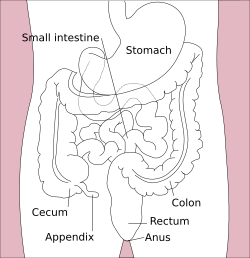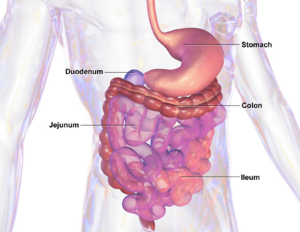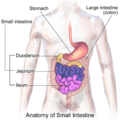Gastrointestinal tract facts for kids
Quick facts for kids Gastrointestinal tract |
|
|---|---|
 |
|
| Diagram of stomach, intestines and rectum in the average human | |
| Latin | Tractus digestorius (mouth to anus), canalis alimentarius (esophagus to large intestine), canalis gastrointestinales (stomach to large intestine) |
| System | Digestive system |
The gastrointestinal system is your body's amazing way of handling food. It's also called the digestive system. This system takes the food you eat and breaks it down into tiny chemicals. These chemicals can then be absorbed by your body. They are used for energy and to help your body grow and repair itself.
After your body uses what it needs, the digestive system also gets rid of the waste. This whole process starts at your lips and finishes at your anus. Many animals, like worms, insects, mammals, birds, fish, and people, all have digestive systems.
The main part of this system is the gastrointestinal tract, often called the gut. It's like a long, winding tube that food travels through. Other organs also help with digestion, even though food doesn't pass directly through them.
Here are the main parts of the gut in humans:
Other important organs that help the digestive system work are:
- Liver and gallbladder
- Pancreas
- Salivary glands, lips, teeth, tongue, epiglottis, thyroid, and parathyroids
Food does not go through these organs. But they make special liquids and hormones that help the gut digest food. For example, the pancreas makes insulin, which helps your body use sugar.
Many diseases can affect the gastrointestinal system. Doctors who specialize in this area are called gastroenterologists.
Contents
Your Digestive Tract
How it's Built
Your digestive tract has different parts. We can look at it in two ways: how it looks from the outside (gross anatomy) and how it looks under a microscope (microscopic anatomy). The tract is usually split into an upper part and a lower part. The intestines are also divided into small and large sections.
Upper Digestive Tract
The upper part of your digestive tract includes your mouth, pharynx (throat), esophagus (food pipe), stomach, and the first part of your duodenum.
There's a special muscle called the suspensory muscle of the duodenum. This muscle acts like a border. It separates the upper digestive tract from the lower one. Doctors use this border to figure out where problems, like bleeding, might be happening.
Lower Digestive Tract
The lower part of your digestive tract includes most of your small intestine and all of your large intestine. The word "intestine" can also be called "bowel" or "gut". It's the long tube that goes from your stomach all the way to your anus.
In humans, the small intestine has three main parts: the duodenum, jejunum, and ileum. The large intestine also has several parts: the cecum, colon (which has ascending, transverse, descending, and sigmoid sections), rectum, and anal canal.
Small Intestine
The small intestine starts after the stomach at the duodenum. It's a long, tube-like organ, usually about 6 to 7 meters (about 20-23 feet) long in an adult. Its main job is to absorb the good stuff from your food. This includes things like carbohydrates (sugars), proteins, fats, and vitamins. These nutrients then go into your bloodstream.
The small intestine has a huge inner surface area. This is because it has many folds and tiny finger-like bumps called villi. These help it absorb as much as possible.
Here are its three main parts:
- Duodenum: This is the first and shortest part, about 20–25 cm (8-10 inches) long. It receives partly digested food, called chyme, from the stomach. It also gets special liquids from the pancreas and gallbladder. These liquids contain digestive enzymes that break down proteins and fats. The duodenum also makes a mucus-rich liquid to protect itself from stomach acid.
- Jejunum: This is the middle part of the small intestine, about 2.5 meters (8 feet) long. It also has folds and villi to increase its surface area. Most of the nutrients, like sugars, amino acids, and fatty acids, are absorbed into your blood here.
- Ileum: This is the final section of the small intestine, about 3 meters (10 feet) long. It has villi too. Its main job is to absorb vitamin B12 and bile acids, along with any other nutrients that are left.
Large Intestine
The large intestine is also called the colon. It includes the cecum, rectum, and anal canal. The appendix, a small finger-shaped organ, is attached to the cecum.
The colon is divided into several parts:
- Cecum (the very first part) and the appendix
- Ascending colon (goes up on the right side of your belly)
- Right colic flexure (a bend near your liver)
- Transverse colon (goes across your belly)
- Left colic flexure (a bend near your spleen)
- Descending colon (goes down on the left side of your belly)
- Sigmoid colon (a S-shaped loop before the rectum)
- Rectum
- Anus
The main job of the large intestine is to absorb water from the remaining waste. This helps form solid waste that your body can get rid of.
Related pages
Images for kids
See also
 In Spanish: Tracto gastrointestinal para niños
In Spanish: Tracto gastrointestinal para niños



